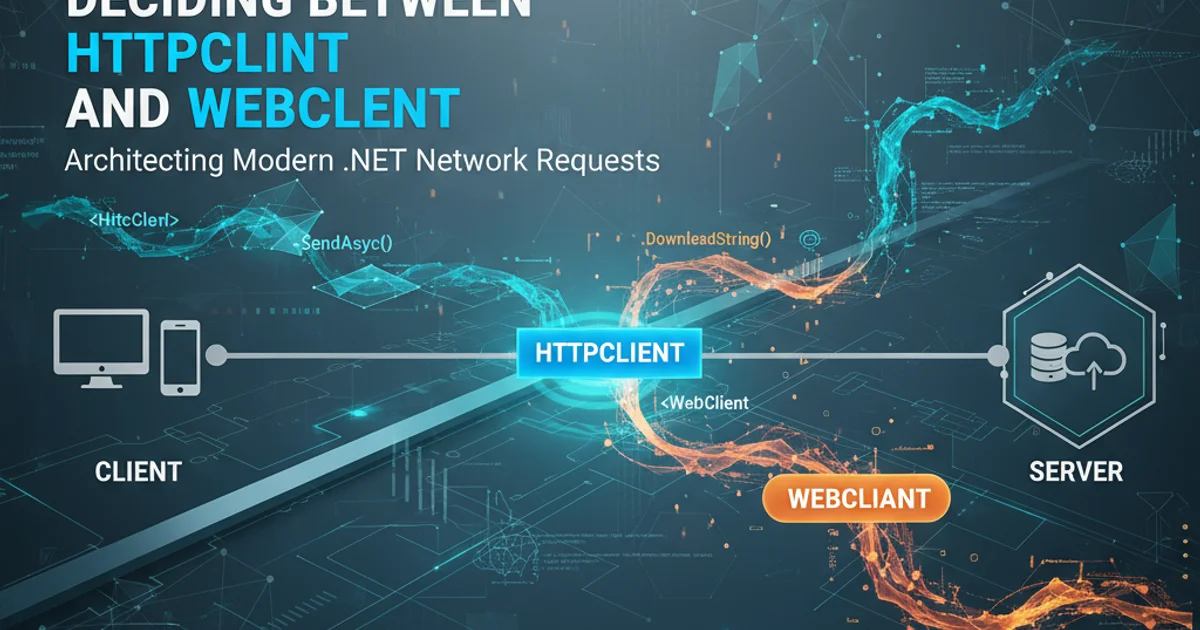Deciding between HttpClient and WebClient
Categories:
HttpClient vs. WebClient: Choosing the Right Tool for .NET Web Requests

Navigate the complexities of making HTTP requests in .NET. This article compares HttpClient and WebClient, guiding you to select the optimal API for your C# applications, focusing on modern best practices and performance.
In the world of .NET development, making HTTP requests is a fundamental task. Whether you're consuming a REST API, downloading files, or interacting with web services, you'll need a reliable client. For many years, WebClient was the go-to choice. However, with the evolution of .NET and the increasing demands of modern web applications, HttpClient has emerged as the preferred and more powerful option. This article will delve into the differences, advantages, and disadvantages of both, helping you make an informed decision for your projects.
Understanding WebClient: The Legacy Option
System.Net.WebClient is a high-level class that provides a simple way to send data to and receive data from a URI. It's part of the .NET Framework since version 2.0 and offers synchronous and asynchronous methods for common tasks like downloading strings, files, or uploading data. While easy to use for basic scenarios, WebClient has several limitations that make it less suitable for modern applications.
WebClient is considered obsolete in modern .NET development. It's built on older asynchronous patterns (APM/EAP) and lacks features crucial for performance and reliability in contemporary web applications. Microsoft's documentation explicitly recommends using HttpClient instead.Introducing HttpClient: The Modern Standard
System.Net.Http.HttpClient was introduced in .NET Framework 4.5 (and is fundamental in .NET Core/5+). It's designed for modern web applications, offering a more flexible, efficient, and robust way to handle HTTP requests. HttpClient supports asynchronous operations using async/await, allowing for non-blocking I/O and better scalability. It also provides advanced features like request/response interceptors, custom message handlers, and better connection management.
flowchart TD
A[Start Application] --> B{Need HTTP Request?}
B -->|Yes| C{Basic, Fire-and-Forget?}
C -->|Yes, Legacy .NET| D[Use WebClient (Obsolete)]
C -->|No, Modern .NET or Complex| E[Use HttpClient]
E --> F{Need Advanced Features?}
F -->|Yes| G[HttpClient: Message Handlers, Pooling]
F -->|No| H[HttpClient: Basic Usage]
G --> I[Optimal Performance & Scalability]
H --> I
D --> J[Potential Issues: Resource Exhaustion, Blocking]
I --> K[End]
J --> KDecision Flow for Choosing between WebClient and HttpClient
Key Differences and Why HttpClient Wins
The choice between HttpClient and WebClient boils down to several critical differences that impact performance, resource management, and maintainability. HttpClient addresses many of the shortcomings of WebClient.
Asynchronous Operations
WebClient primarily uses the Event-based Asynchronous Pattern (EAP) or Asynchronous Programming Model (APM), which are older and more cumbersome to work with. HttpClient, on the other hand, fully embraces the Task-based Asynchronous Pattern (TAP) with async/await, making asynchronous code much cleaner and easier to manage. This is crucial for responsive applications that don't block the UI or thread pool while waiting for network operations.
using System.Net.Http;
using System.Threading.Tasks;
public class HttpClientExample
{
private static readonly HttpClient _httpClient = new HttpClient();
public async Task<string> GetDataAsync(string url)
{
HttpResponseMessage response = await _httpClient.GetAsync(url);
response.EnsureSuccessStatusCode(); // Throws an exception if the HTTP response status is an error code
string responseBody = await response.Content.ReadAsStringAsync();
return responseBody;
}
}
Example of asynchronous GET request using HttpClient
Connection Management and Resource Leaks
One of the most significant issues with WebClient is its poor connection management. Each WebClient instance can potentially open a new TCP connection, leading to socket exhaustion if not properly disposed of or if many requests are made concurrently. HttpClient is designed to be reused across multiple requests. It manages an internal pool of connections, which significantly improves performance and prevents resource exhaustion.
HttpClient throughout the lifetime of your application. Do NOT create a new HttpClient for each request, as this can lead to socket exhaustion and performance degradation. For advanced scenarios, consider IHttpClientFactory in ASP.NET Core for managing HttpClient instances with policies like retries and circuit breakers.Extensibility and Message Handlers
HttpClient offers a powerful extensibility model through HttpMessageHandlers. These handlers can be chained together to intercept and modify requests and responses, allowing for features like logging, caching, authentication, retries, and more, without altering the core request logic. WebClient lacks this level of extensibility.
using System.Net.Http;
using System.Threading;
using System.Threading.Tasks;
public class CustomLoggingHandler : DelegatingHandler
{
protected override async Task<HttpResponseMessage> SendAsync(
HttpRequestMessage request, CancellationToken cancellationToken)
{
System.Console.WriteLine($"Request: {request.Method} {request.RequestUri}");
HttpResponseMessage response = await base.SendAsync(request, cancellationToken);
System.Console.WriteLine($"Response: {response.StatusCode}");
return response;
}
}
// Usage:
// var httpClient = new HttpClient(new CustomLoggingHandler());
Example of a custom HttpMessageHandler for logging requests
When to Use Which (and Why HttpClient is Almost Always Better)
Given the advantages of HttpClient, it should be your default choice for almost all new development in .NET. WebClient might still be encountered in legacy codebases, but even there, migrating to HttpClient is often a worthwhile endeavor for improved performance, reliability, and maintainability.

Feature Comparison: WebClient vs. HttpClient
1. For New Projects
Always use HttpClient. It's the modern, recommended approach for all HTTP communication in .NET Core, .NET 5+, and even new development in .NET Framework.
2. For Existing Projects (WebClient)
Consider refactoring to HttpClient. While WebClient might still function, migrating will improve performance, reduce resource consumption, and make your code more robust and easier to maintain. This is especially true for applications making frequent or concurrent HTTP requests.
3. For Simple, One-Off Scripts (Rarely)
In extremely rare cases, for a very simple, non-critical script that needs to download a single file or string and doesn't require advanced features, WebClient could be used for its brevity. However, even then, the overhead of HttpClient is minimal, and its benefits still outweigh the slight verbosity.